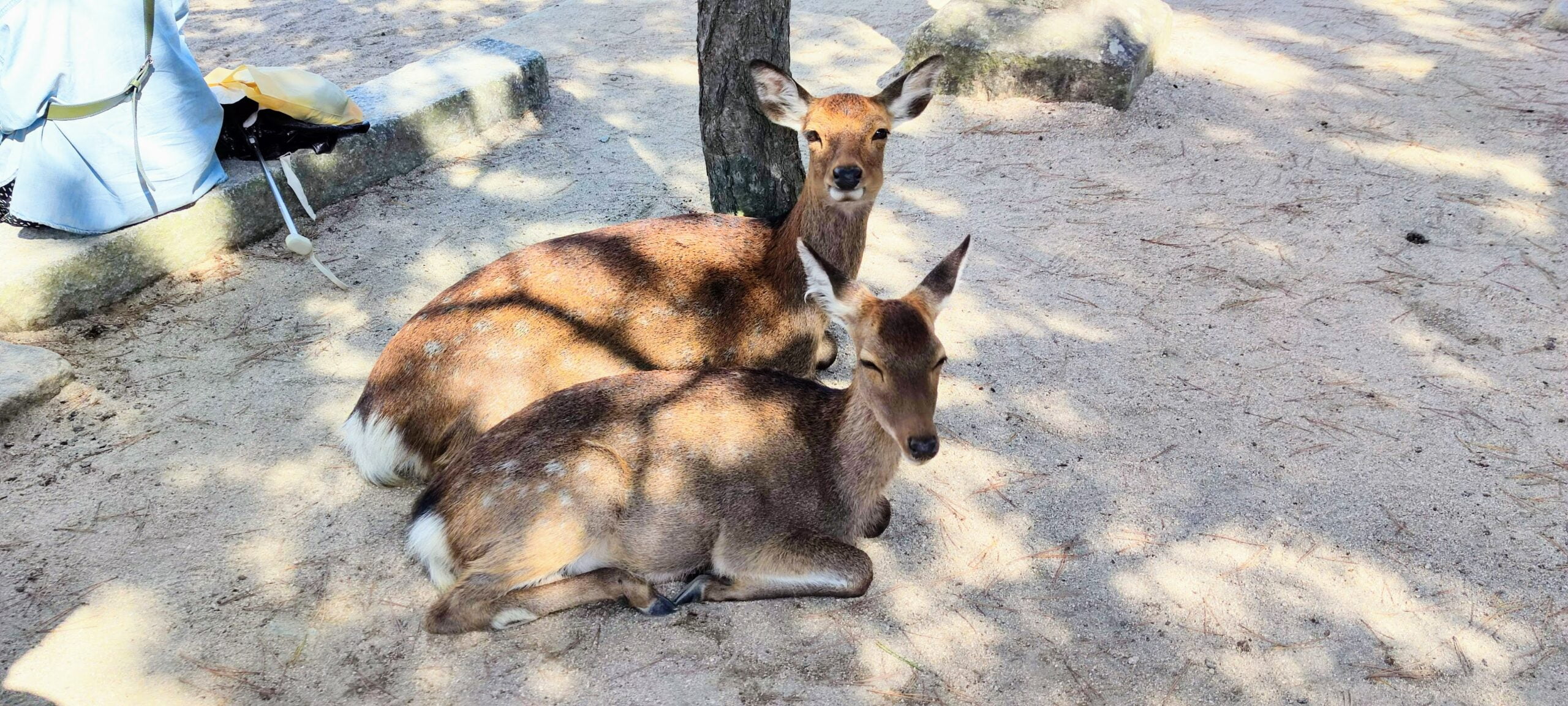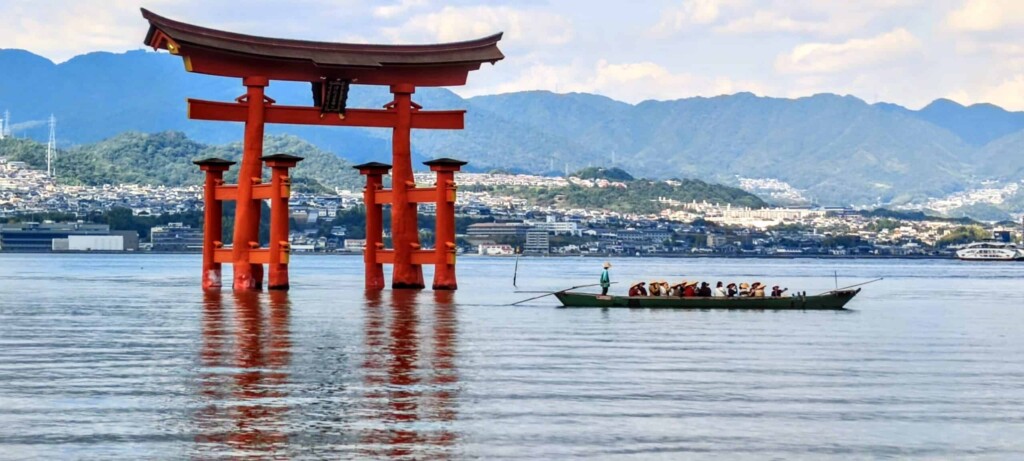Are you someone who loves to travel and is searching for an captivating destination to add to your list of places to visit? Look no further, than Miyajima, an island situated in the Seto Inland Sea of Japan. With its beauty, deep cultural heritage and famous attractions Miyajima provides an unforgettable experience for all kinds of travelers. Lets explore the world of Miyajima together and find out why it deserves a spot on your travel itinerary.

Miyajima, also known as Itsukushima Island is famous for its scenery that leaves visitors amazed. When you arrive at the island by ferry you’ll be welcomed by the sight of the floating torii gate of Itsukushima Shrine. This striking vermillion gate stands elegantly in the water forming a picture view against the backdrop of mountains.
Once you set foot on the island take a walk through the enchanting Momijidani Park, where you can admire the hues of maple trees during autumn. The park also offers hiking paths that lead to Mount Misen, Miyajimas peak. From the mountaintop you’ll enjoy views of the Seto Inland Sea and the neighboring islands.

Miyajima is rich, in history. Holds spiritual importance in Japan. The island houses the UNESCO World Heritage site, Itsukushima Shrine, a gem dating back, to the century. Known for its architecture and mesmerizing reflection in the water during tide the shrine invites visitors to explore its intricate halls, pagodas and gardens while delving into its rich Japanese cultural significance.
Another spot worth visiting is the Daisho in Temple, a sanctuary radiating tranquility and spirituality. Adorned with over 500 stone statues each conveying its expression and message this temple offers a peaceful retreat to reflect on ancient wisdom.
Nature enthusiasts will discover a wealth of wildlife on Miyajima. From roaming deer considered sacred by customs to charmingly adding an element of delight to your visit.
For those in search of adventure Miyajima presents opportunities for hiking, kayaking and even scuba diving. Embark on a trek up Mount Misen where encounters with other hikers await amidst awe inspiring panoramic views, along the journey. Discover the waters surrounding the island by diving or kayaking immersing yourself in the marine life below.
A trip, to Miyajima isn’t complete without savoring its delights. The island is renowned for its seafood, its prized oysters. Whether you prefer them grilled or in a rice bowl Miyajima’s oysters are a delicacy not to be overlooked.
Take a stroll through Omotesando Shopping Street and sample local street food like Hiroshima style okonomiyaki (a pancake) or momiji manju (maple leaf shaped cakes). These delectable treats are ideal for satisfying your appetite while exploring the islands shops and boutiques.
To get to Miyajima hop on a train from Hiroshima to Miyajimaguchi Station then enjoy a ferry ride to the island. The ferry runs frequently throughout the day for your convenience.
When planning your trip remember that Miyajima experiences seasons, each with its charm. Spring brings cherry blossoms, in bloom while autumn dresses up the island in shades of red and gold. Consider timing your visit to witness natures beauty at its peak. Miyajima provides a variety of accommodations ranging from ryokans, to hotels. You can wake up to views of the islands beauty or enjoy authentic Japanese hospitality for a truly immersive experience.
Known as a treasure Miyajima captivates travelers worldwide with its landscapes, sacred locations and welcoming atmosphere. It’s a destination for those craving peace and cultural exploration. Whether you enjoy adventures historical sites or culinary delights Miyajima has something for everyone. Get ready to pack your bags and set off on an adventure, to this island – Miyajima is eagerly awaiting your visit!
A little bit of history
- Miyajima, also known as Itsukushima, is a small island located in the Hiroshima Bay, Japan. It has a rich history dating back to ancient times.
- The island is famous for its iconic Itsukushima Shrine, which was first built in the 6th century. The shrine is known for its unique “floating” torii gate, which appears to be standing in the water during high tide.
- During the Heian period (794-1185), Miyajima became an important religious site and a place of pilgrimage. Many Buddhist temples and Shinto shrines were built on the island during this time.
- In the 12th century, the Taira clan, one of the most powerful samurai families, took control of Miyajima and established a military base there. They built fortifications and a castle on the island to defend against potential attacks.
- During the Sengoku period (1467-1615), Miyajima was attacked and conquered by various warlords. The island exchanged hands multiple times and witnessed several battles.
- In the late 16th century, the famous warlord Toyotomi Hideyoshi visited Miyajima and ordered the construction of a grand hall within the Itsukushima Shrine complex. The hall, known as the “Senjokaku,” was intended as a place for Buddhist sutra chanting.
- In 1555, Miyajima suffered a devastating fire that destroyed many of its buildings, including parts of the Itsukushima Shrine. However, the shrine and its torii gate were later rebuilt and restored to their former glory.
- During the Meiji period (1868-1912), Miyajima underwent significant changes as Japan opened up to the outside world. Modern infrastructure, such as roads and bridges, were constructed on the island to accommodate increasing tourism.
- Miyajima played a role in World War II when it served as a military base for the Japanese Navy. The island was heavily bombed by Allied forces during the war, causing significant damage to its buildings and natural environment.
- After World War II, Miyajima was designated as a UNESCO World Heritage site in 1996. Today, it remains a popular tourist destination known for its stunning natural beauty, historical significance, and cultural heritage.
Best Time to Visit
Best Time to Visit Miyajima
The best time to visit Miyajima is during spring (March to May) and autumn (September to November). During these seasons, the weather is mild and pleasant, and you can enjoy the vibrant cherry blossoms in spring or the beautiful autumn foliage. The summer months can be quite hot and humid, while winter brings colder temperatures. However, Miyajima is a popular tourist destination all year round, so you can plan your visit based on your preferences and availability.
Do’s & Don’ts
Must Do and See in Miyajima
Here are some must-see attractions and activities in Miyajima:
- Itsukushima Shrine: Visit the iconic shrine with its floating torii gate.
- Mount Misen: Hike or take a ropeway for panoramic views.
- Daisho-in Temple: Explore the important Buddhist temple and Henjokutsu Cave.
- Miyajima Aquarium: See marine life from the Seto Inland Sea.
- Momijidani Park: Enjoy the autumn foliage and serene atmosphere.
- Omotesando Shopping Street: Shop, dine, and try Hiroshima-style okonomiyaki.
- Oyster Tasting: Sample fresh oysters in various dishes.
These are just a few highlights of what Miyajima has to offer. Enjoy your visit!
Things you should avoid doing in Miyajima
When visiting Miyajima, there are a few things you should avoid doing to ensure a respectful and enjoyable experience:
- Do not touch or feed the wild deer: Miyajima is known for its friendly deer population. While they may seem approachable, it’s important to remember that they are still wild animals. Avoid touching or feeding them as it can disrupt their natural behavior and potentially harm them.
- Do not remove or damage any natural or cultural artifacts: Miyajima is home to several sacred and historical sites, including Itsukushima Shrine and its famous floating torii gate. It is essential to respect these cultural treasures and refrain from removing or damaging any artifacts.
- Do not litter: Keep Miyajima clean by disposing of your trash properly. There are designated trash bins throughout the island, so make sure to use them. Avoid leaving any waste behind, including cigarette butts.
- Do not climb on or deface trees or structures: Miyajima’s forests are home to diverse plant and animal species. Climbing on trees can cause damage to the ecosystem and disrupt wildlife habitats. Additionally, refrain from defacing any structures or carving your name into trees or buildings.
- Do not swim in prohibited areas: While the beaches around Miyajima may be tempting for a swim, some areas are designated as off-limits due to safety concerns or environmental preservation efforts. Follow the signs and guidelines provided to ensure your safety and protect the island’s natural resources.
Remember, respecting the local culture, wildlife, and environment is crucial when visiting Miyajima or any other destination. By being mindful of these guidelines, you can contribute to the preservation of this beautiful island for future generations to enjoy.
Hotels
Here is a list of some hotels located on Miyajima Island, along with their contact information:
- Kikunoya
- Address: 335 Miyajimacho
- Rating: 4.4 (522 reviews)
- Kikunoya Hotel Information
- Miyajima Grand Hotel Arimoto
- Address: Miyajimacho, 南町364
- Rating: 4.4 (736 reviews)
- Miyajima Grand Hotel Arimoto Information
- Miyajima Kinsuikan
- Address: 1133 Miyajimacho
- Rating: 4.3 (926 reviews)
- Miyajima Kinsuikan Information
- Hotel Miyajima Villa
- Address: 1165 Miyajimacho
- Rating: 4.5 (560 reviews)
- Hotel Miyajima Villa Information
These links will direct you to Google search results where you can find more detailed information about each hotel, including their official websites, amenities, and booking options.








